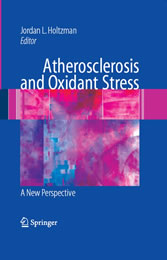Suchen und Finden
Preface
5
Contents
6
Contributors
8
The Pathogenesis of Atherosclerosis and Plaque Instability
10
Creation of the Lipid Core
11
Local Inflammation in the Vessel Wall
13
Thinning of the Fibrous Cap
14
References
16
Epidemiological Studies on Atherosclerosis: The Role of the Mediterranean Diet in the Prevention of Cardiovascular Disease
20
Introduction
20
The Mediterranean Diet and Risk of CVD
21
Observational Study Results
21
Clinical Trial Results – Variations to the Mediterranean Diet
25
The Lyon Diet Heart Study
25
Indo-Mediterranean Diet Heart Study
26
Clinical Feeding Study Results
27
The Dash Trials
27
OMNI Heart Trial
28
Mediterranean Diet Effects on Oxidative Stress
29
Summary and Conclusion
31
References
32
Interventional Trials of Antioxidants
34
Introduction
34
Basic Laboratory Research
34
Observational Epidemiology
35
Rationale for Randomized Trials
37
Vitamin E Primary Prevention Trials
37
Vitamin E Secondary Prevention Trials
40
Beta-carotene Primary Prevention Trials
44
Beta-carotene Secondary Prevention Trials
47
Vitamin C Trials
49
Combination Antioxidant Primary Prevention Trials
49
Combination Antioxidant Secondary Prevention Trials
51
Conclusions
54
Recommendations
55
References
55
Oxidative stress and Hypertension
60
Introduction
60
The Paradigm of Oxidative Stress: Reduction– Oxidation Concepts
61
Vascular Production of Reactive Oxygen Species
63
Vascular NAD(P)H Oxidases
63
Uncoupling of NOS
66
Vascular Antioxidant Defense Systems
67
Molecular Targets of Reactive Oxygen Species in Vascular Cells
67
Transcription Factors
68
Protein Tyrosine Phosphatases
69
Protein Tyrosine Kinases (PTK)
69
Mitogen-Activated Protein Kinases
70
Cation Transport Systems
70
Vascular Mechanisms of Oxidative Stress in Hypertension
71
Reactive Oxygen Species Influence Vascular Structure and are Pro-inflammatory
71
Reactive Oxygen Species Reduce NO Bioavailability
71
Reactive Oxygen Species in Hypertension
72
Oxidative Stress in Experimental Models of Hypertension
72
Oxidative Stress in Human Hypertension
73
Therapeutic Potential of Altering Bioavailability of Reactive Oxygen Species
73
Conclusions
77
References
78
Lipids, Oxidation, and Cardiovascular Disease
88
The Impact of Cardiovascular Disease and Its Major Component, Coronary Heart Disease on Human Health
88
Blood Lipids and Coronary Heart Disease
89
The Influence of Dietary Fats on Blood Cholesterol Levels and Distribution of Fatty Acids
90
The Pathogenesis of Coronary Heart Disease
92
Oxidized Lipids and Atherosclerosis
94
Mitochondria, Oxidative Stress, and Bioactive Lipids: A New Concept
96
Controlled Release of Reactive Oxygen Species for Mitochondria and Cellular Redox Signaling Pathways
97
Pathways Influenced by Mitochondrial ROS and Oxidized Lipids
98
Oxidized LDL, Signal Transduction Pathways, and Protection of Vascular Cells
98
Summary
99
References
100
Nuclear Receptors in the Control of Lipid Metabolism
105
The Nuclear Receptor Superfamily
105
Class I Receptors – the Classic Nuclear Hormone Receptors
107
Class II – the Metabolic Sensors
109
Class III and Class IV – the Orphans
117
Nuclear Receptors as Potential Therapeutic Targets for Metabolic Diseases
118
Conclusion
120
References
120
Diabetes and Oxidant Stress
132
Definition and Prevalence of Diabetes
134
Chronic Complications of Diabetes and Risk Factors
134
Definition and Mechanisms of Oxidative Stress
136
Measurement of Oxidative Stress
137
Is Oxidative Stress per se Increased in Diabetes and Vascular Damage?
139
The Link Between Oxidative Stress and Vascular Damage in Diabetes
149
Treatment of Oxidative Stress
150
Conclusion and Future Directions
153
References
154
Molecular Mechanisms of Environmental Atherogenesis
168
Epidemiology of Cardiovascular Disease
168
Atherosclerosis
169
Response to Injury Hypothesis
169
Clonal Expansion Hypothesis
171
Pathogenesis of Atherosclerosis
172
Environmental Risk Factors
173
Atherogens vs. Carcinogens
176
Reactive Oxygen Species and Oxidative Stress
177
Cellular Redox Reactions
178
Redox Cycling
178
Reactive Oxygen Species and Atherosclerosis
179
Reactive Oxygen Species as Second Messengers
180
Reactive Oxygen Species as Protein Modifiers and Phosphorylation Mediators
181
Benzo[a]pyrene
182
Bay Region Hypothesis
182
Metabolism of Benzo[a]pyrene, Enzyme Systems and Reactivity of Metabolites
183
Target Organs and Cellular Localization of Benzo[a]pyrene
187
Benzo[a]pyrene Carcinogenicity
187
Macromolecular Adduction
189
Benzo[a]pyrene and Atherosclerosis
191
Modulation of Gene Expression by Benzo[a]pyrene through the Aryl Hydrocarbon Receptor
192
c-Ha-ras
194
Signal Transduction through the Ras Pathway
195
c-Ha-ras and Atherosclerosis
197
c-Ha-ras and Benzo[a]pyrene
198
c-Ha-ras and Redox Signaling Pathways
198
Mitogenic Signaling Induced by Benzo[a]pyrene
199
Oxidant-Regulated Signaling in vSMCs
200
Antioxidant/Electrophile Response Element
201
Protein Binding to ARE/EpRE
202
Concluding Remarks
203
References
204
The Role of Glutathione Pathways in the Prevention of Atherosclerosis
220
The Role of Oxidized Serum Lipids in the Chronic Vascular Inflamation Associated with the Development of Atherosclerosis
220
Mechanisms for the Initiation of Vessel Injury by Oxidized Lipids
221
The Role of Antioxidant Systems in the Protection of the Vessel Wall from Oxidant Injury
222
The Correlation between the GSH and Cysteine Levels and Vascular Disease
222
The Selenium Dependent GSH-Peroxidases and Paraoxonases
223
The Role of GPx1 in the Prevention of Vascular Injury
224
The Role of GPx3 in the Prevention of Vascular Disease
226
The Role of the Gluthathione S-Transferases Polymorphinsms in the Development of Vascular Disease
229
Effect of Ischemic Heart Disease, Diabetes Mellitus and Chronic Renal Failure on the GSH Peroxidases
232
Ischemic Heart Disease
232
Diabetes Mellitus
232
The Effect of Renal Failure on the Antioxidant Pathways
234
The Effect of Drugs on the GSH Dependent Pathways
234
Hormone Replacement Therapy
234
Statins and Fibrates
235
Conclusions
236
References
236
Index
249
Alle Preise verstehen sich inklusive der gesetzlichen MwSt.
























